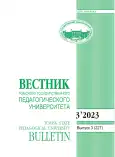Non-homogeneous (polycode, polymodal, multimodal) texts have long become part of modern communication (both media and official business). The requirement for mandatory communication of official authorities, public and party organizations with the population in a virtual environment has given rise to official portals of regional governments, ministries at various levels, and city administrations. These virtual objects are institutional because they have a discursive orientation, specific means of information transfer and communication design. The communicative-activity approach is applicable to the texts contained on the official portals of the city administration (in this article we are talking about the virtual portal of the Administration of Omsk Omsk. rf, located at: https://www.admomsk.ru/web/guest/main). The purpose of the article is to evaluate the ways of transmitting information, organizing communication with different age and social groups of the addressee in terms of the manifestation in them of visual, verbal, multimodal regulators that implement communicative and cognitive models of the virtual institutional environment. Material for this study: texts posted on the virtual portal of the administration of the city of Omsk (Omsk. rf.). The research methodology includes two stages: 1. Evaluation of visual, verbal, multimodal regulators, their communicative orientation in terms of expressing communicative and cognitive models of the virtual institutional discursive environment; 2. Identification of texts aimed at certain social and age groups of addressees, establishing their informational, semantic, communicative, cognitive composition as an environment for forming the image of the addressee and addressee. The main results of the analysis of the form and content of the portal showed the following. The portal structure includes a typical navigation frame with a fairly simple system of linear vertical and horizontal links. The content level is represented by interconnected verbal and visual components. Their different ratio in different parts of the content, the quality and quantity of inhomogeneous units is due to the goals of the section (transmission of information / impact on the emotive, aesthetic sphere of the addressee), the relevance of the information contained for the addresser and addressee. The communicative and cognitive levels form verbal and visual communicative and cognitive models that convey a predominantly regional formation, affecting the emotional sphere of an addressee that is indefinite in social, gender, age terms - a city resident, establishing an interactive connection with the latter. The communicative-activity approach to a non-homogeneous text of an institutional type - the official portal of the Administration of the city of Omsk, showed a variety of means of communication (visual and verbal), one-sidedness of communication, typical for virtual objects of this level. The method of designating a collective addresser is indicated in the name of the portal through an indication of ownership (portal of the Administration of Omsk), corresponds to the legal norms of institutional discourse. The category of the addresser is specified at the factual level in the part of the portal “Administration” with the help of the Mayor’s personal page, description of the Mayor’s office, legal grounds for activity, etc. The addresser’s communication is focused on a regionally limited collective addressee - residents of Omsk (Omsk). Less often, the addressee is limited by territory, age, social group. The category of the addressee in the texts of the portal is expressed by indirect means - the names of age social, gender and other groups and their representatives in the headings of the content and within the texts that fill it. Special appeals to an indefinite addressee are single, associated with current events in the city, weather, etc. The structure of the horizontal-vertical links of the portal’s navigation frame, the “duplication” of the content components in the header and footer parts direct the addressee’s attention to the hyperlinks he needs, ensuring comfort and utility of perception. But the titles of these hyperlinks do not reveal the impactful (emotive, expressive, aesthetic) strategies that are found in a number of pieces of content. They are implemented using a variety of static and dynamic infographics, they are found only after opening a hyperlink. The leading means of polycode, polymodal, multimodal implementation of the informing strategy are the thematic, logical, plot-compositional levels of the content of the portal as a whole, texts in its parts. The nominations of hyperlinks and the leads of the texts contained in them, together with the photographs accompanying the links, perform the functions of attracting the reader’s attention and informing. The portal contains a multifaceted system of regulators due to the multimodal nature of this virtual object. The system includes: explicit visual (horizontal) regulators that attract and localize the attention of the addressee with the help of color, size, location in the space of the portal interface, creating contrast, meaning a certain topic, problem, information or supplementing it; visual vertical regulators associated with calls for specific actions; visual hidden regulators (photos, infographics - photo report, photo report, photo story, photo tour, performing the functions of influencing the emotional and aesthetic spheres of the recipient’s perception; diagrams, graphs, drawings, tables, performing the functions of concentrating a large amount of information, illustrating, simplifying perception), the existence of which is found only after opening hyperlinks; explicit verbal horizontal and vertical regulators that nominate sections of content, hyperlinks, etc., conveying mainly information and through it by lexical, stylistic (a combination of neutral, special and colloquial vocabulary), digital, graphic (font, underlining, color highlighting) means that implement “anchoring” the attention of the addressee; polymodal regulations (video about the professional activities of employees of the City Administration, the mayor, city utilities).
 7-14
7-14


 15-23
15-23


 24-31
24-31


 32-39
32-39


 40-47
40-47


 48-57
48-57


 58-66
58-66


 67-75
67-75


 76-85
76-85


 86-94
86-94


 95-102
95-102


 103-111
103-111


 112-119
112-119


 120-127
120-127


 128-135
128-135


 136-144
136-144








